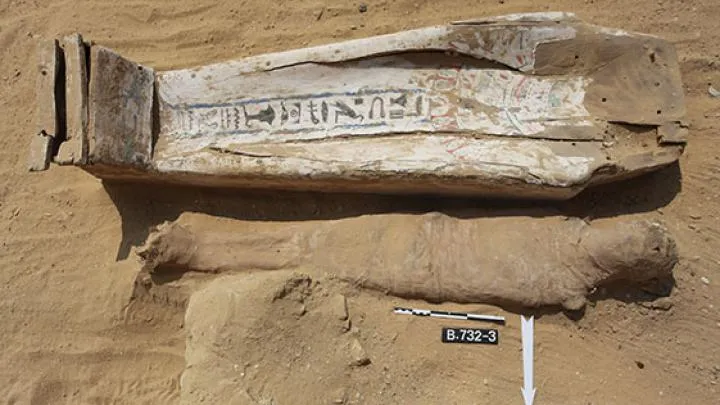
Polish archaeologists discovered dozens of mummies dating back 2,000 years during excavations in the vicinity of the world`s oldest pyramid at the necropolis in Saqqara in northern Egypt. The majority of the mummies were buried directly in the sand, the researchers report.
Excavations in the extensive necropolis in Saqqara have been conducted by the Polish team for over two decades.
"Most of the mummies we discovered last season were very modest, they were only subjected to basic embalming treatments, wrapped in bandages and placed directly in pits dug in the sand" - head of excavations, Dr. Kamil O. Kuraszkiewicz from the Department of Egyptology, Faculty of Oriental Studies, University of Warsaw told PAP.
During the last research campaign in September 2018, researchers focused their efforts on uncovering the section between the area adjoining the Pyramid of Djoser (the oldest pyramid in the world) and the western section of the so-called Dry Moat. The latter is a 20 m deep and about 40 m wide trench carved in the rock, which surrounds the sacred area of the oldest Egyptian pyramid.
Kuraszkiewicz recounts that most of the burials were very poorly preserved. All organic materials, including wooden coffins, decayed in the case of burials located within the "Dry Moat".
Decoration on one of the wooden coffins, in which a mummy was buried, caught the researchers` attention. A multicolour necklace is visible at the neck, and an imitation of the hieroglyphic inscription is painted on the lid.
"Apparently, the artisan who painted it could not read, and perhaps he tried to recreate something that he had seen before. In any case, some of the painted shapes are not hieroglyphic signs, and the whole does not form a coherent text" - notes the Egyptologist.
Kuraszkiewicz also points to an unusual decoration on the part of the coffin covering the feet. "There are two beautifully clumsy images of Anubis in the form of lying jackals in a completely unusual blue colour" - he adds.
Anubis was the Egyptian god depicted as a canine or a man with a canine head. He was associated with mummification and the afterlife. Presented as the African jackal, he was usually black. Perhaps this unusual blue colour is a reference to the fact that, according to Egyptian beliefs, the hair of the gods (and in this case the hair of the divine jackal) were made of precious blue stone, Kuraszkiewicz says.
Unfortunately, already in the antiquity, the ornamented coffin was a victim of thieves, who stole its carved mask depicting the deceased.
Excavations west of the pyramid in Saqqara were initiated more than 20 years ago by Prof. Karol Myśliwiec as part of a concession granted to the Polish Centre of Mediterranean Archaeology of the University of Warsaw. So far, archaeologists have managed to determine that two necropolises were located west of the Pyramid of Djoser complex; one, in which the nobles from the 6th Dynasty (2345-2118 BC) were buried, consists of burial chapels made of mud bricks and tombs carved in the rock.
Above the older necropolis, archaeologists discovered a vast cemetery from the end of Pharaonic Egypt - the Late, Ptolemaic and Roman Period (6th century BC - 1st century AD). In total, Polish archaeologists have discovered over 500 simple burials. According to Egyptologists, ordinary people were buried in that necropolis, not the then elites. Dozens of burials discovered during the last research season were in this part of the ancient cemetery.
During the period when the cemeteries functioned, Egypt lost its independence and initially was under the Persian rule. Then the state of the pharaohs was conquered by Alexander the Great. His successors started in Egypt the longest-reigning dynasty (the Ptolemaic dynasty), among other dynasties in the Hellenistic kingdoms. The most famous representative of that dynasty was the legendary Cleopatra VIII. (PAP)
author: Szymon Zdziebłowski
szz/ agt/ kap/
tr. RL
















